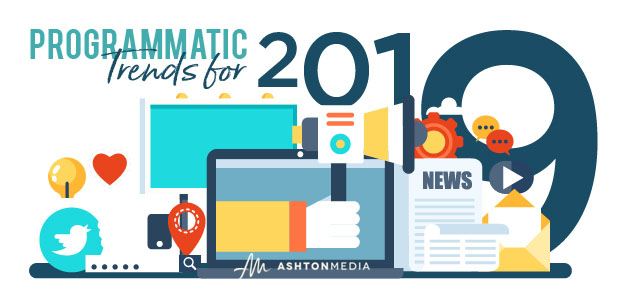
9 Programmatic Trends 2019
With Australia’s Programmatic Summit just around the corner, we asked seasoned marketer and programmatic enthusiast Louise Crompton, for her thoughts on the programmatic trends for 2019:
1. Marketers are continuing to take control back
This is not about whether you trade media directly, through an agency or a hybrid model (although my sources suggest hybrid seems to be most popular at the moment for a number of reasons), it’s about marketers taking ownership of their technology partnerships and accessing the audiences they want directly from publishers. This is all about owning and protecting the data. Ensuring it’s being harnessed for your competitive advantage and not enriching someone else’s data set.
2. Stack Simplification
There is a growing trend to reduce the complexity of technology stacks and for a more aggregated view of the customer. According to Adobe’s Managing Director for the Ad Cloud, Sam Smith, it’s the reason Adobe is seeing 50% of it’s new business growth for this product. “ It’s about a holistic view of the customer in one place. One report card, one taxonomy, the ability to de-dupe audiences and manage frequency across the customer journey,” he says. Continuing consolidation of adtech and martech companies will also help this along. At the end of the day, not only does the customer benefit from more relevant messaging through the funnel, but the marketer wins too, with greater operational efficiencies.
3. More brand dollars flowing into programmatic
Is it as simple as more traditional above-the-line inventory (TV, Audio, OOH) being made available in new programmatic trading environments? Or, are the Binet, Field, Sharp views on brand growth, through a long and short term balance of spend, reaching a tipping point? Or, maybe it’s increasingly sophisticated programmatic trading with richer targeting parameters that are suited for brand messaging. (Side note; the NY Times launched Project Feel last year. This allows advertisers to target content predicted to evoke specific reader emotions). Regardless, the more insight that comes from dynamic and data driven trading, the more smart marketers will be able to prove the importance of investment higher up the funnel. Or as I like to say, “brand greasing the funnel!”
4. VOZ
Could this be the Holy Grail we’ve been waiting for? Coming this year, Oztam’s VOZ aggregates viewing across linear TV, connected TV and other connected devices through its panel of 12,000 homes and 7 million connected devices. Not only will we have a de-duped, cross device view of reach and frequency for TV investments, but an ability to onboard 1st party advertiser datasets to target beyond standard demographics. Exactly how this data flows into DMPs and programmatic TV trading environments is yet to be seen, but hopefully it’s a sign of good things to come.
5. Video, video and more video
And its not just about broadcast content. According to the 2018 Zenith Online Video Forecast, online video is the fastest growing digital channel with nearly half of all video viewed on mobile. Pubmatic analysis (2019 Global Digital Ad Trends Report) echoes this with 25% yoy growth in spend predicted for Australia, making it one of the top programmatic video ad spending markets in the world. Looks like we are going to be busy creating more video content and hopefully more of it personalised, as video technology like Spirable becomes available.
6. GDPR
Yes I know this was so 2018, but with the ACCC’s ongoing Digital Platform Inquiry and full report due in June, there will be even more reason to get clued up on data use and data privacy in 2019. Whilst global brands and Australian businesses interacting with European markets are ahead as a result of GDPR, Steve Hunt, MD Universal Music, urges marketers to get on top of it before it impacts them. “Understanding how these changes impact your collection and use of data, especially for data driven marketing is critical,” he says. Timothy Whitfield CTO of BurstSMS agrees. “This is bigger than Y2K and people are not prepared. People need to know how to handle their data.”
7. Header bidding
Adoption for this has ramped up over the last 24 months and Australian publisher header bidding is now at 80-90% penetration according to Jonas Jaanimagi the Technology Lead for the IAB in Australia. For those of you not across it here’s Margot Robbie in a bathtub to explain. Header bidding enables publishers to push their inventory to all authorized SSPs at the same time rather than what was done previously – sequential waterfall approach. It has created a more open market place, generally increased CPMs and generated much more data. As a result, there is a rise of different strategies for bidding and the growth of something called SPO – supply path optimization. These are algorithms to help create more direct routes to winnable inventory in the open real time marketplaces. A good one to talk to your agency or technology partner about to see what strategies they are employing.
8. Open RTB 3.0 – say what!!
I’m not going to even try to get too technical here. But what you need to know is that the IAB have just released a new set of standards to improve transparency by certifying supply. According to Jonas Jaanimagi “the new protocols will now go through a phase of testing and validation by the industry. A deadline for adoption is yet to be set.“ It builds on earlier protocol updates, that required publishers to show which 3rd party marketplaces (SSPs) had the authority to sell their inventory. Digiday explains that with this latest protocol, information that passes between buyer and seller at each stage of the digital supply chain is validated and effectively signed off using encrypted signatures. “Ultimately having more visibility and accountability is positive for the industry. It will help the industry mature and overcome a lot of existing issues around fraud through better transparency and security,” says Chris Levings, Head of WooliesX Digital Media Strategy.
9. Amazon
Move over Google, there’s another incredibly rich intent data source coming to town. The Amazon Advertising Platform (AAP) is a DSP that enables advertisers to reach Amazon’s audiences on third party publisher sites. Timothy Whitfield explains, “think about the amount of data that Amazon collects. Each time you buy a product they know your likes, your address, probably your work address and based on your purchase history they can deduce your level of affluence and life stage. These are not the type of probabilistic datasets that we have seen in programmatic previously, this is factual information.” The question is how will Amazon deal with GDPR and the Australian Data Privacy policy? News on the street is this will be here before the middle of the year.
If you want to know more about these trends, hear case studies from the marketers agencies and technologists that are pushing the boundaries in Australia and overseas, come along to the 2019 Ashton Media Programmatic Summit on March 7th at Sydney’s ICC. You can buy tickets here.
Author
Louise Crompton
Former Director Marketing ANZ, Expedia Group

Louise Crompton is a data driven marketing leader. She has 20 years experience building iconic brands predominantly in digital and ecommerce environments.
